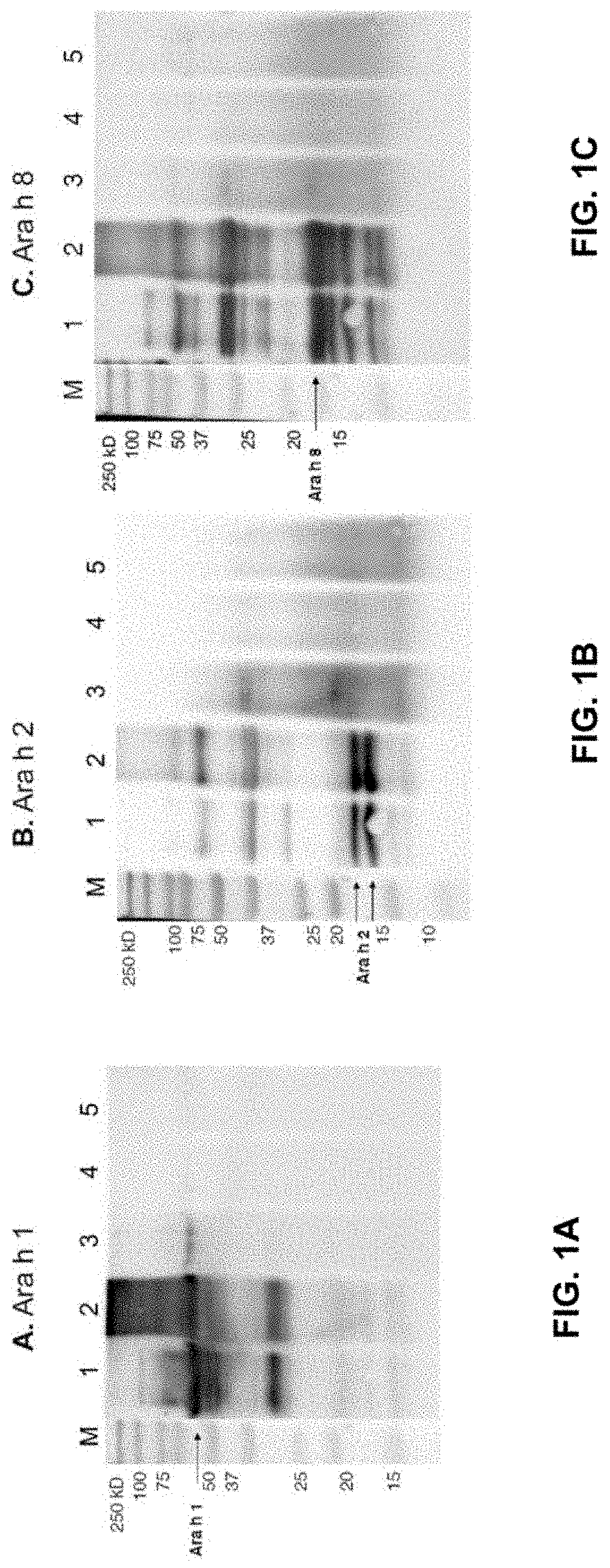Peanut hypoallergenic formulations for determining the risk of anaphylaxis
a technology of anaphylaxis and peanuts, which is applied in the field of peanut hypoallergenic formulations for determining can solve the problems of significant allergic reaction risk and the inability of the treatment to lead to complete tolerance, and achieve the effects of increasing and reducing the risk of anaphylaxis
- Summary
- Abstract
- Description
- Claims
- Application Information
AI Technical Summary
Benefits of technology
Problems solved by technology
Method used
Image
Examples
example i
ization of Processed Peanut Compositions
[0078]Physical Peanut Processing. Commercially purchased peanuts (Montreal Food Store, Canada) were purchased raw and shelled. Peanuts were roasted with their seed coating in a convection oven at 150° C. for 30 minutes or were autoclaved in a tabletop autoclave at 136° C. at 2.48 Bar (36 psi) for 30 minutes. Additionally, roasted peanuts were autoclaved (Roast-Auto) and autoclaved peanuts were roasted (Auto-Roast), after a 30-minute pause at room temperature between processing methods. Analyses were performed in comparison with raw peanut (unprocessed).
[0079]Defatting into flour. Raw, roasted and autoclaved peanuts (6 to 12 of each) were ground into a smooth paste using a coffee grinder. The smooth paste was then suspended in hexanes and the peanut flour was collected by filtration under vacuum.
[0080]Preparation of Whole Peanut Protein Extracts. Dry peanut flours (raw, roasted and autoclaved) were processed into whole peanut protein extracts u...
example ii
terization of a Processed Peanut Preparation
[0116]Chemicals. 3-(Trimethylsilyl-propionic-2,2,3,3-d4) acid (TSP-d4) and deuterium oxide (D2O) were purchased from Sigma-Aldrich.
[0117]Sample Physical Processing. Commercially purchased peanuts (Montreal Food Store, Canada) were purchased raw and shelled. Peanuts were roasted with their seed coating in a convection oven at 150° C. for 30 minutes or were autoclaved in a tabletop autoclave at 136° C. at 2.48 Bar (36 psi) for 30 minutes. Analyses were performed in comparison with raw peanut (unprocessed).
[0118]Defatting into flour. Raw, roasted and autoclaved peanuts (6 to 12 of each) were ground into a smooth paste using a coffee grinder. The smooth paste was then suspended in hexanes and the peanut flour was collected by filtration under vacuum.
[0119]NMR Sample Solid Preparation. Small pieces (6 mg) of whole, intact peanut or defatted peanut flour (4 mg) collected from raw, roasted or autoclaved peanuts were loaded into a KeI-F, disposabl...
PUM
| Property | Measurement | Unit |
|---|---|---|
| temperature | aaaaa | aaaaa |
| temperature | aaaaa | aaaaa |
| pressure | aaaaa | aaaaa |
Abstract
Description
Claims
Application Information
 Login to View More
Login to View More - R&D
- Intellectual Property
- Life Sciences
- Materials
- Tech Scout
- Unparalleled Data Quality
- Higher Quality Content
- 60% Fewer Hallucinations
Browse by: Latest US Patents, China's latest patents, Technical Efficacy Thesaurus, Application Domain, Technology Topic, Popular Technical Reports.
© 2025 PatSnap. All rights reserved.Legal|Privacy policy|Modern Slavery Act Transparency Statement|Sitemap|About US| Contact US: help@patsnap.com



